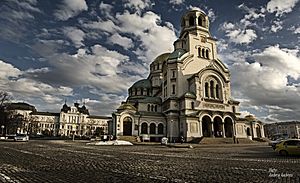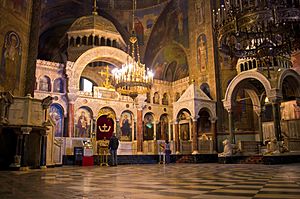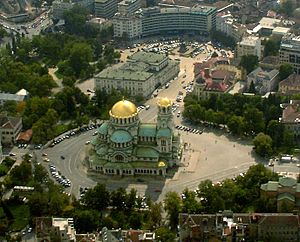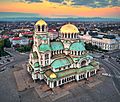Saint Alexander Nevsky Cathedral, Sofia facts for kids
Quick facts for kids The St. Alexander Nevsky Cathedral |
|
|---|---|
|
Храм-паметник "Свети Александър Невски"
|
|
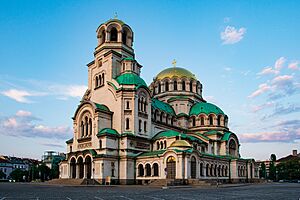
Alexander Nevsky Cathedral, Sofia
|
|
| Religion | |
| Affiliation | Bulgarian Orthodox |
| Ecclesiastical or organizational status | Stauropegion |
| Leadership | Daniil of Bulgaria |
| Year consecrated | 1924 |
| Location | |
| Location | Sofia, Bulgaria |
| Architecture | |
| Architect(s) | Alexander Pomerantsev |
| Architectural style | Neo-Byzantine |
| Groundbreaking | 3 March 1882 |
| Completed | 1912 |
| Specifications | |
| Capacity | 5000 (worshipers) 86,0003 (volume) |
| Length | 73.5 m |
| Width | 52.2 m |
| Interior area | 3,170 m2 |
| Height (max) | 53.0 m (top cross bell tower) |
| Dome height (outer) | 46.3 m (top dome) |
| Dome dia. (outer) | 22 m |
| Dome dia. (inner) | 18 m |
The St. Alexander Nevsky Cathedral is a very famous and beautiful church in Sofia, the capital city of Bulgaria. It belongs to the Bulgarian Orthodox Church. This huge building is designed in the Neo-Byzantine style, which means it looks like old churches from the Byzantine Empire. It is the main church for the Patriarch of Bulgaria, who is the leader of the Bulgarian Orthodox Church.
This cathedral is one of the largest Christian churches in the world. It can hold about 5,000 people inside. It is also the biggest cathedral in the Balkans region. Many people consider it a symbol of Sofia and a popular place for tourists to visit.
Contents
History and Design of the Cathedral
The idea to build the St. Alexander Nevsky Cathedral started in 1879. Construction began in 1882 when the first stone was laid. Most of the building work happened between 1904 and 1912. The cathedral was built to honor the Russian soldiers who died during the Russo-Turkish War of 1877–1878. This war helped Bulgaria become free from the Ottoman Empire.
The main architect who designed the cathedral was Alexander Pomerantsev. He worked with other architects like Alexander Smirnov and Alexander Yakovlev. Many artists and workers from Bulgaria, Russia, and other European countries helped build and decorate the church. Some of these talented people included Petko Momchilov and Ivan Mrkvička.
The beautiful marble parts and the lights inside the cathedral were made in Munich, Germany. The metal parts for the gates came from Berlin, and the gates themselves were built in Vienna, Austria. The colorful mosaics you see inside were brought all the way from Venice, Italy.
Cathedral's Amazing Features
The Alexander Nevsky Cathedral is a type of church called a cross-domed basilica. This means it has a main dome in the center and is shaped like a cross. The main dome is covered in gold and is about 45 meters (148 feet) high. If you include the cross on top, it reaches 46.3 meters (152 feet). The bell tower is even taller, reaching 53 meters (174 feet).
The church has 12 bells that weigh a total of 23 tons. The heaviest bell alone weighs 12 tons! Inside, the cathedral is decorated with beautiful Italian marble in different colors. You can also see shiny Brazilian onyx and alabaster. Around the central dome, the Lord's Prayer is written in thin gold letters.
Changes to the Cathedral's Name
The cathedral's name was changed for a short time between 1916 and 1920. During World War I, Bulgaria and Russia were on opposite sides. Because of this, the church was temporarily called the Sts. Cyril and Methodius Cathedral. However, after the war, its original name, St. Alexander Nevsky, was given back. The cathedral was officially opened on September 12, 1924. In 1955, it was recognized as an important cultural monument.
Special Relics Inside
To the left of the main altar, there is a special case. Inside, you can see relics of Alexander Nevsky. These were given to the cathedral by the Russian Orthodox Church. A relic is a special object connected to a saint. The item on display looks like a piece of a rib.
Museum and Market Nearby
Down in the crypt of the cathedral, there is a museum of Bulgarian icons. This museum is part of the National Art Gallery. The church says that this museum has the largest collection of Orthodox icons in all of Europe. Icons are special religious paintings.
Close to the cathedral, there is also a park. In this park, you can find a small flea market. Here, you can buy handmade textiles, icons, and old items.
Other Places to See Nearby
The St. Alexander Nevsky Cathedral is located near many other important places in Sofia. Right next to it is the St. Sofia Church. The city of Sofia is actually named after this older church!
Other famous landmarks close by include:
- The Monument to the Unknown Soldier
- The Bulgarian Academy of Sciences
- The National Gallery of Foreign Art
- The National Art Academy
- The Bulgarian Parliament building
- A park with a monument and grave for the famous writer Ivan Vazov
- The Sofia Opera and Ballet Theater
Images for kids
Gallery
See also
 In Spanish: Catedral de Alejandro Nevski de Sofía para niños
In Spanish: Catedral de Alejandro Nevski de Sofía para niños
- List of churches in Sofia
- List of largest Eastern Orthodox church buildings
- List of tallest domes


